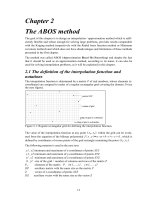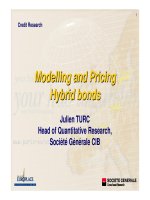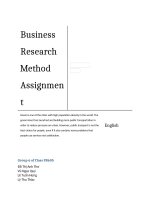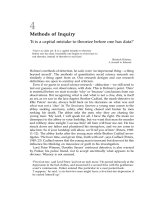2. Lecture 2 - Quantitative Research Method Final
Bạn đang xem bản rút gọn của tài liệu. Xem và tải ngay bản đầy đủ của tài liệu tại đây (1.93 MB, 64 trang )
Lecture 2 –
Quantitative
research methods
Process of Quantitative Research
Process of Quantitative Research
Concepts and the measurement of concept:
•Concepts are the building blocks of theory and represent the
points around which business research is conducted.
•E.g: structure, agency, deskilling, organizational size,
technology, charismatic leadership, followers, TQM, functional
subcultures, knowledge, managerial identity, motivation to
work, moral awareness, productivity, stress management,
employment relations, organizational development,
competitive success, etc.
Process of Quantitative Research
Concepts and the measurement of concept:
• Bulmer (1984: 43) succinctly puts it, concepts ‘are categories for the
organization of ideas and observations’
•E.g: IQ is not a concept! It is a measure of a concept—namely, intelligence.
•The concept of intelligence has arisen as a result of noticing that some
people are very clever, some are quite clever, and still others are not at all
bright.
•These variations, we have come to call the concept of ‘intelligence’ seem
important, because we might try to construct theories to explain these
variations.
Process of Quantitative Research
Concepts and the measurement of concept:
•If a concept is to be employed in quantitative research,
it will have to be measured.
•Once they are measured, concepts can be in the form of
independent or dependent variables.
•In other words, concepts may provide an explanation of
a certain aspect of the social world, or they may stand for
things we want to explain
Process of Quantitative Research
Concepts and the measurement of concept:
•A concept of organizational performance
• may be used in either capacity: for example, as a possible explanation of
culture (are there differences between highly commercially successful
organizations and others, in terms of the cultural values, norms, and beliefs
held by organizational members?)
• or as something to be explained (what are the causes of variation in
organizational performance?)
•The concept of worker quality, job satisfaction, ..etc.
Process of Quantitative Research
Why measure the concepts?
There are 03 main reasons for measurement in quantitative research.
1.Measurement allows us to delineate fine differences between
people in terms of the characteristic in question.
2.Measurement gives us a consistent device or yardstick for making
such distinctions.
3.Measurement provides the basis for more precise estimates of the
degree of relationship between concepts (for example: correlation
analysis)
Process of Quantitative Research
Why measure the concepts?
E.g: Thus, if we measure both job satisfaction and the
things with which it might be related, such as stressrelated illness, we will be able to produce more
precise estimates of how closely they are related than
if we had not proceeded in this way.
Process of Quantitative Research
Indicators v. measure:
•Measure refer to things that can be relatively unambiguously
counted: At an individual level: personal salary, age, or years of
service; at an organizational level: annual turnover or number
of employees. => Measures, in other words, are quantities.
•Indicators are used to tap concepts that are less directly
quantifiable. eg. job satisfaction...need indicators that stand for
the concept.
Process of Quantitative Research
Indicators:
In order to provide a measure of a concept (often referred
to as an operational definition, a term deriving from the
idea of operationalization), it is necessary to have an
indicator or indicators that will stand for the concept.
e.g: using litmus paper to measure
pH level
Process of Quantitative Research
Indicators:
There are a number of ways in which indicators
can be devised:
-Through a question/questions: e.g. Attitude (job satisfaction), status
(job title), behavior (job tasks)
-Through the recording of individuals’ behaviour using a structured
observation schedule : e.g. managerial activity, consumers’ behavior
(Williness to pay – WTP)
Process of Quantitative Research
Indicators:
There are a number of ways in which indicators
can be devised:
-Through official statistics: Workplace Employment Relations Survey
(WERS) data to measure UK employment policies and practices; CPI,
PCI, PAPI...etc.
-Through an examination of mass media content analysis: fb,
twitter...etc.
Process of Quantitative Research
Indicators:
•Direct and indirect indicators of concepts: Indicators may be direct or
indirect in their relationship to the concepts for which they stand. E.g.:
an indicator of marital status has a direct relationship to its concept
than an indicator (or set of indicators) relating to job satisfaction.
•Sets of attitudes always need to be measured by indirect indicators. It
is similar to many forms of behaviour.
•When indicators are used that are not true quantities, they will need
to be coded to be turned into quantities. Eg: male = 1, femal = 2. etc..
Process of Quantitative Research
Indicators: Likert scale (1-5; 1-7)
•Likert scale is used to measure believe, attitute, and
behavior of people toward an issue/concept.
•Eg. Ethical
- accepting gifts/favours in exchange for preferential
treatment;
- passing blame for errors to an innocent co-worker;
Process of Quantitative Research
Indicators: Likert scale (1-5; 1-7)
-divulging confidential information;
- calling in sick to take a day off;
- pilfering organization’s materials and supplies; •
-giving gifts/favours in exchange for preferential
treatment;
- claiming credit for someone else’s work
Process of Quantitative Research
Indicators: Likert scale (1-5; 1-7)
1. Asking the attitude:
Do you think that actions below are ethical or unethical/ Please give
your scaore to actions below!
five-point scale: 1 = unethical; 5 = ethical
Actions
...
...
Score (1-5)
Process of Quantitative Research
Indicators: Likert scale (1-5; 1-7)
2. Asking about their behavior:
How often do you do following actions!
five-point scale: 1 = infrequently; 5 = frequently
Actions
...
...
Score (1-5)
Process of Quantitative Research
Dimensions of concepts:
•The general approach to measurement is to consider
the possibility that the concept in which you are
interested comprises different dimensions.
•This specification of the dimensions of a concept
would be undertaken with reference to theory and
research associated with that concept.
Process of Quantitative Research
Dimensions of concepts:
Eg.: four dimensions of cultural difference: power
distance, uncertainty avoidance, individualism, and
masculinity.
e.g.: poverty, gender inequality, market power,
competitiveness, competency..etc.
Process of Quantitative Research
Dimensions of concepts:
Motivating Potential Score (MPS) of a job:
1. Skill variety: ‘The job requires me to use a number of complex or high-level skills.’
2. Task identity: ‘The job provides me with the chance completely to finish the pieces of work
I begin.’
3. Task significance: ‘This job is one where a lot of other people can be affected by how well
the work gets done.’
4. Autonomy: ‘The job gives me considerable opportunity for independence and freedom in
how I do the work.’
5. Feedback: ‘The job itself provides plenty of clues about whether or not I am performing
well.’
Process of Quantitative Research
Dimensions of concepts:
•Respondents are asked to indicate how far they think each statement
above is accurate, from 1 = very inaccurate, to 7 = very accurate, with a
study of 658 individuals working in 62 different jobs across 7 organizations.
•Interpreting an individual’s MPS score involves comparison with norms for
specific job ‘families’: technical jobs have an average MPS of 154, whereas
clerical jobs normally have a score of 106.
•Workers who exhibit high growth need strength, adequate knowledge,
and skill, and are satisfied with their job context, are expected to respond
best to jobs with a high MPS
Process of Quantitative Research
Reliability and validity:
•The reliability is fundamentally concerned with issues
of consistency of measures.
•the stability of a measure is the test–retest method.
This involves administering a test or measure on one
occasion and then readministering it to the same
sample on another occasion.
Process of Quantitative Research
Reliability and validity:
Reliability refers to the consistency of a measure of a concept. The following are
three prominent factors involved:.
1. Stability: whether or not a measure is stable over time, so that we can be
confident that the results relating to that measure for a sample of respondents do
not fluctuate. This means that, if we administer a measure to a group and then
readminister it, there will be little variation over time in the results obtained.
2. Internal reliability: whether or not the indicators that make up the scale or index
are consistent—in other words, whether or not respondents’ scores on any one
indicator tend to be related to their scores on the other indicators.
Process of Quantitative Research
Reliability and validity:
Reliability refers to the consistency of a measure of a concept. The following are
three prominent factors involved:.
3. Inter-observer consistency: When a great deal of subjective judgement is
involved in such activities as the recording of observations or the translation of data
into categories and where more than one ‘observer’ is involved in such activities,
there is the possibility that there is a lack of consistency in their decisions. This can
arise in a number of contexts, for example: in content analysis where decisions
have to be made about how to categorize media items; when answers to openended questions have to be categorized; or in structured observation when
observers have to decide how to classify subjects’ behaviour
Process of Quantitative Research
Reliability and validity:
Validity: Validity refers to the issue of whether or not
an indicator/indicators that is devised to gauge a
concept really measures that concept?
•There are several ways of establishing validity are
explored in the text: face validity; concurrent validity;
predictive validity; construct validity; and convergent
validity


![Popular music vol[1] 2 theory and method](https://media.store123doc.com/images/document/14/rc/df/medium_keVOAFxBLn.jpg)






